NOVATO
FIRE PROTECTION DISTRICT
Investigation Analysis
of the
Cedar Fire Incident
Engine 6162 Crew Entrapment,
Fatality, and Burn Injuries
October 29, 2003
Novato Fire Protection District
Overview
Summary
On October 29, 2003 four firefighters from the Novato Fire District were
overrun by fire while protecting structures on the Cedar Fire in San Diego
County, California. One firefighter was killed; one received first, second,
and third degree burns to over 28% of his body and airway inhalation burns.
The other two were treated for minor burns and released from the hospital
on the morning of October 30, 2003.
The Cedar Fire was under the jurisdiction of the California Department
of Forestry and Fire Protection (CDF) the United States Forest Service
(USFS). The California Department of Forestry initiated a Accident Review
investigation on October 29, 2003. The Novato Fire District assigned two
members to the investigative team. Training Battalion Chief Kevin Johnston
represented the District as an Agency Representative and Fire Captain
Jeff Whittet represented the Novato Professional Firefighters Association.
The CDF investigative team collected information and analyzed data using
established wildland fire management guidance. The facts surrounding the
accident are included in the CDF Cedar Fire – Engine Crew Entrapment,
Fatality and Burn Injuries Report which was not available at the time
of the printing of this report.
Novato Fire District Report Procedures
The Novato Fire District assembled a Cedar Recovery Team comprised of
District Chief Officers. Several methods were used to obtain critical
information relating to the burn over.
- Identifying and collecting information associated directly with the
burn over of Engine 6162
- Conducting interviews with NFD members involved in the incident
- Visiting the accident site
- Reviewing the CDF Green sheet and other easily accessible public information
relating to the Cedar Fire
- The crew members of Engine 6162 and the NFD members of the CDF Accident
Investigation Team were given the opportunity to review and provide
input to these documents prior to their release
This report has been compiled specifically for the purposes of detailing
the events that occurred directly to the crew of Engine 6162 on the Cedar
Fire. The report includes a chronological outline of activities from dispatch
through the events of the incident, aswell as an analysis of the use and
effectiveness of equipment, PPE, communication, training, ALS equipment,
fire behavior, and apparatus.
The Novato Fire District
The Novato Fire District is located in northern Marin County, California.
The Fire District encompasses approximately 71 square miles and serves
a population of more than 60,000 citizens. It is bordered on the north
by San Antonio Creek and Sonoma County, by Pacheco Grade and the community
of Marinwood to the south, by the Petaluma River and San Pablo Bay to
the east, and west to a point approximately three miles past Stafford
Lake. The City of Novato, a general-purpose governmental entity, lies
within its boundaries and is served by the District. A large portion of
the District lies within a defined wildland urban interface area.
The Operations Division is comprised of the District emergency response
personnel and equipment. The daily emergency response staffing for the
entire fire district is 20 personnel. This staffing includes one Battalion
Chief, four 3-Person Engine Companies, one 3-Person Truck Company and
two 2-person Paramedic Ambulances. The District has been assigned and
operates OES Engine 235. District personnel cross staff two Type III engines
during the wildland season.
The District provides a full range of emergency response services including
but not limited to, structural fire suppression, wildland fire suppression,
response to hazardous materials incidents, Urban Search and Rescue, water
rescue, vehicle extrication, technical rescue as well as basic life support
and advanced life support medical services. Fire District emergency response
personnel respond to over 4,700 incidents annually, of which approximately
3,000 or 68% are medical in nature, ranging from motor vehicle accidents
and elderly falls to childbirths and heart attacks.
All Novato Fire District safety personnel are either Emergency Medical
Technicians (EMTs) or Paramedics. EMTs provide Basic Life Support (BLS).
EMTs interpret signs and symptoms of injury and disease, and determine
the appropriate course of treatment. EMTs are trained to provide Cardio-Pulmonary
Resuscitation, administer oxygen, control bleeding, and perform spinal
immobilization, splint fractures, as well as any rescue functions needed
to free a trapped victim. Paramedics provide Advanced Life Support (ALS).
A Paramedic is an advanced level of EMT certification. Paramedics must
complete an extensive training program to enable them to perform specialized
skills and procedures. These skills include advanced airway management,
including intubations, intravenous therapy, pharmacology and drug administration,
cardiac monitoring and defibrillation.
All Novato Fire District engine companies have ALS equipment and are
staffed with at least one Firefighter/Paramedic, and thus have the ability
to immediately administer advanced life support (ALS) pre-hospital emergency
medical care upon their arrival. The two District ambulances are staffed
with two paramedics each and respond along with an engine company to all
medical emergencies.
Cedar Fire
The Cedar Fire was reported on Saturday, October 25, 2003, at approximately
5:37 P.M. The fire, burning under a Santa Ana wind condition eventually
consumed 280,278 acres and destroyed 2,232 structures, 22 commercial buildings,
and 566 outbuildings, damaging another 53 structures and 10 outbuildings.
There was one fire fighter fatality, 13 civilian fatalities and 107 injuries.
The fire was under Unified Command with the United States Forest Service,
the California Department of Forestry and Fire Protection, and local government
(see the CDF Green Sheet).
NFD Resource Commitments to Southern California
At the time that the Novato Fire District received a request for a Type
III Engine (Engine 6162 ) to be part of a Task Force dispatched to the
Cedar Fire in San Diego County, it had already committed two Type I engines
to the Southern California Fire siege.
On October 25, 2003 the Novato Fire District committed Engine 6185, with
a crew of three, to the Old Fire as part of Strike Team XMR 2125A, and
OES Engine 235, with a crew of four, to the Grand Prix Fire as part of
OES ST 2803A.
The Dispatch and Travel of Engine 6162 to the Cedar Fire
At approximately 7:00 p.m. on the evening of October 27, 2003, the Novato
Fire District received a request from the Marin County Fire Department
Emergency Communications Center, “Woodacre”, for a Type III
engine to respond to San Diego County to assist with the current wildland
fires. A four person crew consisting of Captain Doug McDonald, Engineer
Shawn Kreps, Engineer Steve Rucker and Firefighter/Paramedic Barrett Smith
were assigned, from an established list, to staff Engine 6162.
The crew had returned to work at 7:30 a. m. that morning, from a four-day
break. They had not worked any extra shifts during the preceding few days,
nor had anyone had any significant record of illness or injury during
the previous weeks. They had a light to moderate call volume that day,
and before the actual dispatch at 9:27 p.m., the crew spent time collecting
the items they would need for an extended assignment.
Engine 6162 was officially dispatched at 9:27 p.m. by “Woodacre”
and traveled from Novato Fire District Station 4, in Novato, to the town
of Ramona in San Diego County. They traveled to the truck scales on eastbound
Highway 580 in Livermore. At the scales they rendezvoused with the Task
Force Leader and Assistant Task Force Leader from Lawrence Livermore Lab
and two of the engines, Engine 1541 from Camp Parks and Engine 334 from
San Ramon Fire Protection District that would eventually compose the five
engine Task Force XAL2005A. The group was designated as a Task Force because
it contained a mixture of Type I and Type III engines. All three engines
and the Task Force Leader left the scales at 12:00 a.m. A fourth engine,
Engine 24 from Vallejo Fire Department met the convoy in Santa Nella.
The Task Force made several pauses for fuel and rest stops along the drive
to the Cedar Fire incident base, stopping for fuel at Santa Nella, Interstate
5/Highway 41, and in Pasadena. The crew rotated driving between Engineer
Kreps, Engineer Rucker, and FF/PM Smith, approximately every 100 miles.
The Task Force arrived at Gillespie Field incident base at 11:00 a.m.
on October 28, 2003 after a 13 ½ hour drive. After checking in
with the Resource Unit they were directed to Base for food and rest.
Assignments on October 28, 2003
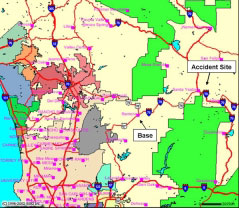 The
crew rested for 2 hours and 15 minutes at Gillespie Field. At 1:15 p.m.
on October 28, 2003, Task Force 2005A was sent to the area of the intersection
of Interstate 8 and Highway 79. They were assigned to a structure protection
operation on Riverview Road (“Camp Oliver”) where they supported
a burnout operation. They were told to hold in the area until 9:30 p.m.
and to patrol for hot spots. The
crew rested for 2 hours and 15 minutes at Gillespie Field. At 1:15 p.m.
on October 28, 2003, Task Force 2005A was sent to the area of the intersection
of Interstate 8 and Highway 79. They were assigned to a structure protection
operation on Riverview Road (“Camp Oliver”) where they supported
a burnout operation. They were told to hold in the area until 9:30 p.m.
and to patrol for hot spots.
During their operations on Riverwood Road, the crew encountered moderate
fire behavior as the fire made downhill runs in heavy brush.
The crew returned to the Gillespie Field staging area at 10:00 p.m. for
dinner and then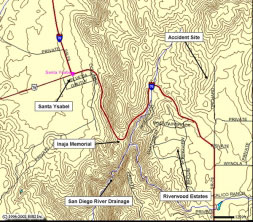 bedded down for the night. Engine 6162 members recall going to sleep between
10:30 p.m. and midnight. They arose between 5:00 a.m. and 6:30 a.m. on
. The crews felt rested and were in good spirits. Their Task Force Leader
attended the morning briefing at approximately 7:00 a.m. while the crew
ate breakfast and completed their typical morning checks on the engine.
They ran the pump, completed the pretrip brake check, and conducted a
check for operational readiness.
bedded down for the night. Engine 6162 members recall going to sleep between
10:30 p.m. and midnight. They arose between 5:00 a.m. and 6:30 a.m. on
. The crews felt rested and were in good spirits. Their Task Force Leader
attended the morning briefing at approximately 7:00 a.m. while the crew
ate breakfast and completed their typical morning checks on the engine.
They ran the pump, completed the pretrip brake check, and conducted a
check for operational readiness.
The Task Force Leader briefed the Task Force on their assignment and
shared safety information. There was only one IAP available for the Task
Force. A fifth engine, Engine 71, a Federal Engine from Ramona was added
to the Task Force.
Engineer Rucker turned in a defective NFD BK radio to Communications
and picked up a replacement so that there were two high band portables
for four personnel on Engine 6162 . Later, one of Engine 6162’s
two BK radios was given to the Task Force Leader because he did not have
one.
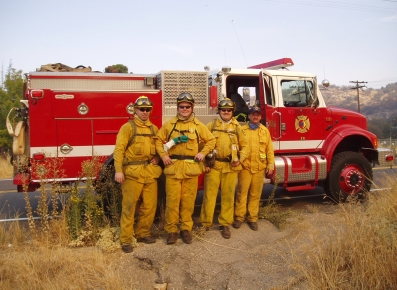
L-R FF/PM Barrett Smith, Engineer Shawn Kreps, Engineer Steve Rucker,
and Captain DougMcDonald at Santa Ysabel on morning of Oct. 29, 2003
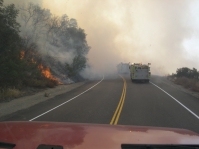
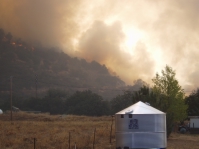
(Right) Slop over Fire after it crossed Highway 78/79 viewed from Santa
Ysabel at 9:47 a.m. on 10/29/03 by crew of Engine 6162. (B. Smith) (Left)
Engine 6162 takes photos as they go through the slop over area. (B.
Smith)
At 8:30 a.m., Task Force XAL2005A left the staging area and headed for
their Branch III, Division I assignment. They arrived at Santa Ysabel
at about 9:15 a.m.
At 9:47 a.m., the Task Force observed, according to Captain McDonald,
that the fire had crossed Highway 78/79 between Santa Isabel and the Inaja
Memorial. (See photo on right) According to Captain McDonald, he could
see engines backing down Highway 78/79 in this area to avoid the fire
that had crossed the highway. By about 10:20 a.m. the Task Force was assigned
to do structure protection in the Riverwood Estates. Captain McDonald
expressed his concern about passing through the area where the fire had
recently crossed Highway 78/79; however, the Task Force was able to pass
through this area without incident.
The crew of Engine 6162 noted that when they arrived in the Riverwood
Estates, a firing operation had already been conducted around the structures
and they conducted mop up operations. They watched as the fire burned
past them to the west in the distance, the area northwest of Highway 78/79
where the fire had jumped the Highway.The fire was calm in the Riverwood
Estates area.
While Captain McDonald and his crew were doing structure protection in
the Riverwood Estates, he had a discussion with members of the crew, including
Engineer Rucker, concerning the use of hose packs. McDonald said that
if there was a need to protect this structure, they would add to the 100’
deployed hose lines an additional 100’ length of hose from one of
their 200’ wildland hose packs.
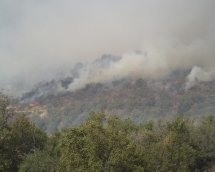
Looking
west from Riverwood Estates towards the slop over above Highway 78/79
at 10:56 A.M. on October 29, 2003. (B.Smith.)
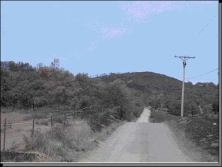
Post fire view from south to north of Orchard Lane. Vehicles parked
on side of the road are located just to the south of the driveway
at 930 and 920 Orchard Lane.
At about 11:00 a.m. the Task Force Leader met with Division I who told
him that he needed to move his Task Force to Orchard Lane because there
was an increase in fire behavior in this area requiring the apparent need
for immediate structure protection.
There was no specific briefing of the Task Force at this time.
At about 11:45 a.m. the Task Force Leader drove North on Orchard Lane
while the Task Force staged at the intersection of Orchard Lane and Highway
78/79. The Task Force Leader called back for the task force team to start
moving up. At this time the crew of Engine 6162 observed the fire crossing
Orchard Lane at the North end. At this time Engine 6162 was the last engine
in line in the Task Force. At about 11:50 a.m. the Task Force arrived
near 915 Orchard Lane. The Task Force Leader began scouting structure
locations near the north end of Orchard Lane.
Due to the fire activity that he observed at the North end of Orchard
Lane Captain McDonald ordered his engine backed up to a grazed field on
the East side of Orchard Lane identified by the crew as a Safety Zone.
The other units of the Task Force backed up with them.
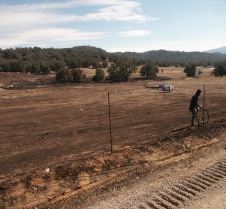
Post fire photo of the grazed field identified as a Safety Zone
by Engine 6162 crew. (D. Northern)
Engine 6162 was assigned to 920 Orchard Lane, the second home from the
north on Orchard Lane by the Task Force Leader. Captain McDonald and the
Task Force Leader discussed the placement of his engine, the need to deploy
hoses, and to clear out the area. Captain McDonald and his crew were comfortable
with their plan.
Captain McDonald ordered Engineer Kreps to back the engine up the cement
driveway at 920 Orchard Lane. He walked up the driveway ahead of the engine
to evaluate the location. Smith and Rucker cut brush that was hanging
over the sides of the cement driveway, and directed the backing of the
engine.
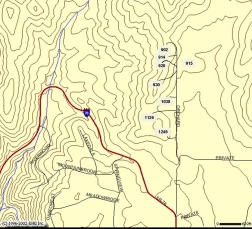
Map of Orchard Lane
was visible to the Southwest. There After walking only as far as the
residence detached garage, Captain McDonald returned to his engine. He
had assessed the situation and expressed some concern about the conditions
to his crew. McDonald radioed the Task Force Leader and advised him that
he didn’t think the house was defendable. The Task Force Leader
told them to come out.
McDonald, Rucker, and Smith walked to the end of the driveway to assess
the conditions closer to the structure. They continued past the front
of the house, which faced west towards the San Diego River drainage and
well beyond where Captain McDonald stopped on his first assessment of
the area. They surveyed their location and found that the brush had been
cleared away below the residence on the west side for about 150 feet.
Because of the conditions they observed they decided the structure could
be defended. Since the brush to the west had been cleared, there was a
view across the canyon to the West and Northwest. Tall brush and drifting
smoke restricted the view to the Southwest.
The single story stucco home had a composition type roof. From their
location they saw smoke to the north (near 902 Orchard Lane) and determined
it to be the main fire and their primary threat. They predicted this fire
would continue to back down the ridge to their location and that it would
remain a flanking fire.
Small runs of fire were occurring across the canyon on the west side
of the drainage as the main fire backed down into the bottom of the canyon.
No fire activity was a wind blowing up canyon and up slope toward the
location of 902 Orchard Lane. Wind speeds were estimated at 7-10 mph.
The crew of Engine 6162 was not aware of any other resources operating
on Orchard Lane other than those assigned to Task Force 2005A. The crew
was also not aware of the exact location of the other resources assigned
to the Task Force.
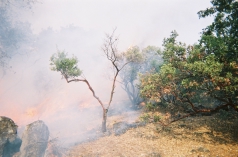
Fire on the ground north of the garage just before Kreps begins to
fire out from this location. This is the same area where Capt. McDonald
saw a CDF Captain that appeared to be preparing to conduct a firing
operation from the top of the driveway. View is to the north towards
902 Orchard Lane (S. Kreps)
After Engine 6162 arrived at the top of the driveway at 920 Orchard Lane,
McDonald conducted a briefing with the crew of Engine 6162 where he explained
the plan of operations, structure preparation, LCES, Safety and Survival
Plans. An axe was placed at the rear door of the structure in preparation
for forcible entry, should it be needed. The chain saw was placed on a
cement patio on the south end of the house after doing some additional
brush clearing. The roof was laddered near the front door using a ladder
found at the residence.
The crew charged the front bumper line to be used as an engine protection
line. Two 100’ long, 1 ½” hose lines were deployed
and charged to protect the structure. These two hoses lines were wyed
off a rear discharge on the engine.
The crew did additional work preparing the residence for the oncoming
flanking fire from the north including the removal of additional brush
down slope from the engine. They moved the brush away and backed the engine
up about ten feet to avoid subjecting it to heat from a brush pile that
they burned below the driveway.
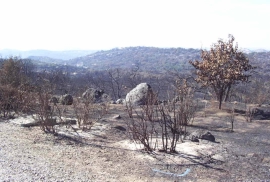
Area below and to the southwest of Engine 6162 where brush had been
cleared and crew strip burned grass stubble. Capt. McDonald threw
fusees into brush below clearing.(R. Lopez)
Captain McDonald walked north on the driveway, and while
near the front door of the residence, he saw a CDF pickup truck drive
up to the top of the driveway and park near the garage. He observed a
CDF Captain who he believed was preparing to conduct a firing operation
near the garage. He was not able to speak with him before he was out of
sight, but Captain McDonald thought the CDF Captain saw him.
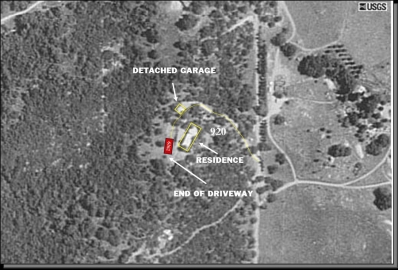
Captain McDonald met with his crew and told them there was a CDF Captain
in the area of the garage that appeared to preparing to conduct a firing
operation. Captain McDonald instructed his crew to fire out the stubble
grass area below the driveway on the West side. This primarily grass area
extended approximately 140’ below the driveway before it reached
the heavy brush line. Kreps walked down the driveway towards the garage
area. He observed fire already on the ground behind the garage and to
the north in the brush. Kreps believed that this was the main fire backing
down the ridge as expected. He began his strip firing from that location
to the south along the edge of the driveway. Captain McDonald threw fusees
down the slope into the heavy brush line 140 feet below the area strip
burned. None of the crew members noted any effect from the use of the
fusees. None of the crew noticed exactly when the CDF pickup left their
location.
At about 12:35 p.m., the Task Force Leader and his assistant arrived
at 920 Orchard to check on Engine 6162’s progress and plans. The
sky was clear overhead and the winds were moderate, still up canyon and
up slope. They spoke with Captain McDonald and discussed Engine 6162.
The Task Force Leader told Captain McDonald he and the crew were doing
a good job. The main fire was continuing to back down (flanking fire)
the ridge from the North and was still about 300 yards north of their
location.
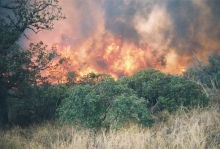 Engineer
Kreps had to wait for several minutes to take the photo to the left because
the primary fire activity at this time was isolated torching in the brush.
In this picture minimal wind activity is observed and the smoke and flame
are standing straight up indicating a minimal wind influence. Engineer
Kreps had to wait for several minutes to take the photo to the left because
the primary fire activity at this time was isolated torching in the brush.
In this picture minimal wind activity is observed and the smoke and flame
are standing straight up indicating a minimal wind influence.
Photo
of the fire picking up over 140’ below Engine 6162 just as the
crew begin to return to the engine from firing out the stubble grass.
(S. Kreps)
About five to eight minutes after the Task Force Leader left the scene,
the crew of Engine 6162 observed an increase in the fire activity down
slope from their location.
The Engine 6162 crew gathered at the engine to discuss the situation.
As the fire intensity increased, the crew decided to move to the passenger
side of the engine away from the radiant heat below them. At this point
Smith staffed a 1 ½” inch hose line at the front passenger
side while Rucker staffed a similar hose line near the rear passenger
side. Engineer Kreps was standing at the rear duals on the passenger side
with his back to the engine.
Captain McDonald remembers being just to the rear of Smith. Kreps recalls
that all four members of the crew made it around to the passenger side
of the engine and that they had been moving around, including walking
to the tailboard of the engine. Kreps had his back to the engine rear
duals, and Rucker was directly in front of him, no more than five feet
away. Captain McDonald had the only portable radio. As Smith took his
position at the front of the engine, he noticed hot embers blowing into
the juniper bushes on the patio behind him. He used his hose to knock
down some fire in the bushes.
At this point Engineer Kreps stepped around the rear of the engine and
took the photo below. Rucker told Kreps to “Get Back”. According
to Kreps, when the photo was taken the conditions had not yet started
to deteriorate. Kreps believes the photo was taken about 20 seconds before
conditions began to change dramatically.
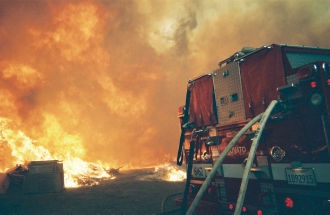 In
the Kreps photo (left), taken from the rear of the engine, the burn pile
can be seen beyond the engine. Fire activity at ground level as well the
smoke appeared to be drawn to the South or Southwest. The engine was sitting
on a flat driveway but the hose strap on the driver’s side rear
appears to be drawn away from the engine. Because the general wind conditions
at the time were from the west there appears to be a local wind condition
or drawing effect influencing the conditions around the crew of Engine
6162 . The sun was now above them and to the south. The convective column
appeared to blocking out the sun at this moment. The fire approaching
from the south or southwest, as described by Captain McDonald, can be
seen in the reflections on the back of the engine. In
the Kreps photo (left), taken from the rear of the engine, the burn pile
can be seen beyond the engine. Fire activity at ground level as well the
smoke appeared to be drawn to the South or Southwest. The engine was sitting
on a flat driveway but the hose strap on the driver’s side rear
appears to be drawn away from the engine. Because the general wind conditions
at the time were from the west there appears to be a local wind condition
or drawing effect influencing the conditions around the crew of Engine
6162 . The sun was now above them and to the south. The convective column
appeared to blocking out the sun at this moment. The fire approaching
from the south or southwest, as described by Captain McDonald, can be
seen in the reflections on the back of the engine.
(Above)
Behind the cover of the passenger side of the engine. (S. Kreps)
Smith describes the conditions as changing from full sunlight when they
went around the engine, to twilight then darkness with smoke and an orange
glow with fire embers blowing past the engine. The heat intensity dramatically
started to increase.
Kreps remembers that this is when the sky got dark, it started getting
very hot, embers were flying everywhere, and it sounded like a freight
train coming.
Captain McDonald remembers that at about this time, the sky started turning
orange, and the conditions started to become untenable. According to Captain
McDonald and Engineer Kreps, the majority of the heat was coming from
the south or southwest.
Captain McDonald recalls seeing a huge orange glow as he looked backwards
over the top of the rear of the engine. He could see the glow through
the trees and tall brush. Engineer Kreps covered his mouth with his gloved
hand and reminded himself to take shallow breaths to protect his airway.
The crew noticed a significant wind increase and then a flaming front
was observed by Smith, blowing across the driveway in the direction of
the garage, cutting off their egress to the Safety Zone in the field off
of Orchard Lane. The Juniper and Boxwood bushes planted along the cement
patio behind them burst into flames.
The situation was deteriorating and the crew decided that before it got
any worse they should take refuge in the structure. At this time Captain
McDonald ordered his crew to move to the shelter of the structure.
Smith, responded to Captain McDonald’s order to get into the structure,
immediately dropped his line and ran in the direction of the three-foot
high raised patio. Once he left the protection of the engine, Smith experienced
severe thermal conditions. He leapt past the burning bushes and onto the
patio. He was followed by Kreps who ran to the steps, stumbled and fell
to his knees at the top of the steps, but then recovered and continued
to retreat behind the rear of the house following Smith. They both covered
over 150 feet in their run from the engine to the rear door of the structure.
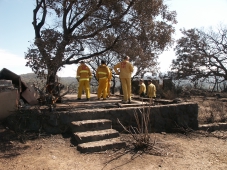
A post incident photo showing Steps leading up to patio. Path which
crew members used to get up onto the patio. (D. Northern)
Captain McDonald moved toward the steps of the patio and accounted for
Kreps and Smith while they ran onto the patio and around the rear corner
of the house. He then turned back toward the rear of the engine to look
for Rucker not understanding why Engineer Rucker was taking so long. Captain
McDonald located Rucker standing near the rear of the engine where Kreps
had last seen him. As Captain McDonald approached he noticed that Rucker
appeared to be disoriented.
Although the CDF Green Sheet indicates
that Engineer Rucker was wearing a hose pack, and that he put it on after
the order to move to the house was given, none of the crew members have
any recollection of Engineer Rucker donning or wearing a wildland hose
pack at 920 Orchard Lane. Captain McDonald has no recollection of instructing
Engineer Rucker to don a hose pack during the incident. These packs were
located in the middle rear compartment of Engine 6162 . An inventory of
the engine after the accident showed that one 200’ wildland hose
pack was missing from this compartment.
Captain McDonald began to yell for Engineer Rucker to move to the structure.
Rucker was slow to respond then turned his head and almost started walking
the opposite way. Captain McDonald continued to yell for Rucker to move
towards the structure and Rucker responded by moving towards McDonald.
Captain McDonald had to cup his hands to his mouth to be heard over the
roar of the fire.
McDonald saw Rucker take two steps toward him and fall to the ground.
McDonald witnessed him stand up, on his own. Engineer Rucker then turned
toward the tailboard of the engine and according to McDonald may have
taken a “half step” in that direction. McDonald remembers
Rucker looking in a southerly direction, at the approaching wall of fire.
McDonald saw Rucker step toward him and then turn toward the bushes along
the patio, and fall face-forward into the burning bushes. Captain McDonald
moved toward Rucker, who was already pushing himself away from the bushes.
Captain McDonald assisted Rucker up and to the steps leading to the elevated
patio. Rucker was able to make it up the steps under his own power, although
he was slightly hunched over at the waist.
According to McDonald sometime between his first fall and when they reached
the steps to the patio Engineer Rucker said “I’m burning up”,
McDonald did not witness any fire on Rucker and did not feel that he was
personally being burnt.
Captain McDonald followed Rucker up onto the concrete patio where Engineer
Rucker fell the final time. Engineer Rucker fell first to his knees and
then face first on to the patio without any attempt to brace his fall.
Engineer Rucker was not responsive at this time. Captain McDonald tried
to get Rucker up but was not able to. According to the CDF Green Sheet,
Captain McDonald made a firefighter down call on his portable radio at
this time. Captain McDonald remembers dropping the portable radio when
it became too hot to hold. Captain McDonald recalls turning 180 degrees
and trying to pull Engineer Rucker up.
Captain McDonald yelled for the other two crew members to return but
could not be heard due to the noise at this point of the fire. Captain
McDonald he realized that he was now being badly burned and that Engineer
Rucker was beyond help.
Captain McDonald made his way around the rear corner of the house.
Meanwhile, Smith and Kreps were at the rear door of the structure where
they used the axe and multiple kicks to force the door open. They both
entered the rear of the residence. Turning around, the two realized that
they were alone. They returned to look for Captain McDonald and Engineer
Rucker.
Smith and Kreps traveled back along the rear of the house to the south
end, using the house as protection. As they neared the southeast corner
of the house, they could see that beyond the end of the house there was
a solid wall of flame blowing sideways and engulfing the patio. As they
arrived at the corner, Captain McDonald staggered around the corner out
of the flames. He appeared burned and dazed.
Captain McDonald told them that Rucker had fallen and they needed to
go back for him. Captain McDonald turned to go back after the fallen Engineer.
Based on their observations of the conditions Kreps and Smith determined
the patio area was not tenable. Taking Captain McDonald with them, the
three retreated back into the rear door of the residence.
Once inside the residence, Captain McDonald realized he was burning and
took off what remained of his web gear. He searched for his King portable
radio to call for help, but he no longer had it with him. The three discussed
a plan to reach Engineer Rucker.
After a moment, a decision was made to open the front door slowly and
check to determine if the outside of the house was tenable. When the door
was opened, intense heat surged through the small opening. The door was
quickly closed. After another few minutes, a decision was made to check
the front door again. This time the heat had subsided and Kreps exited
the doorway in search of the missing Engineer. Smith attempted to exit
the door but was forced back by a wave of heat. He remained inside the
residence and cared for McDonald.
Engineer Kreps moved toward the front bumper line of the engine taking
small shallow breaths and using his shroud to protect his airway. As Kreps
passed the front of the concrete patio, he saw the body of Rucker midway
across the patio. The engine was still running at a high idle as he had
left it. He continued to the bumper hose line and advanced it toward Rucker.
He opened the nozzle, but only had 10 to 15 seconds before he ran out
of water. The fire had burned through the rear hose lines on the engine
and the tank had been pumped dry. The engine, however, appeared to be
basically undamaged and drivable.
In an instant, the fire intensity increased, forcing Kreps to take shelter
in the rear seat of the engine. Once inside, Engineer Kreps considered
deploying the extra fire shelters stored in the cab. Recognizing there
was nothing he could do for Engineer Rucker and concerned that Smith and
McDonald would come searching for him, Kreps took a single breath and
ran back to the front door of the structure. Smith, in the house, opened
the door to go look for Engineer Kreps, who burst through the door at
the same moment.
While the three of them sat inside near the front entrance of the house,
the north end of the structure began to burn. Smoke banked down to waist
level, dropping like a curtain, and a decision was made by the group to
try to get back to the engine. Knowing there was no hope for Engineer
Rucker and the house would soon be fully involved the three exited the
front door and headed for the engine. Captain McDonald was assisted to
the front passenger seat. Smith ran to the rear of the engine and disconnected
the two protection lines. He got into the rear passenger seat while Kreps
got into the driver’s seat.
Engineer Kreps began to drive the engine slowly down the driveway toward
the north heading for Orchard Lane. Heavy dark smoke obscured the driveway
and Kreps was forced to feel his way down the concrete, using the feel
of the tires as they dropped off the edge of the concrete to make corrections.
At one location he stopped the engine to avoid running off the road and
being lodged against a tree. Kreps knew that there was a significant curve
in the driveway, which if he missed it, would take them off the driveway
and down a steep slope. The crew was still concerned about being overrun
by the fire again. A gust cleared just enough smoke for Engineer Kreps
to make an adjustment and they were able to move forward again.
During the descent of the driveway, Captain McDonald was able to transmit
a fire fighter down message on Command Net using the mobile radio.
Kreps drove to the bottom of the driveway and onto Orchard Lane and then
headed south. Captain McDonald made another announcement on the Command
Net using the mobile radio. Inexplicably, Captain McDonald ordered the
engine to stop in the road and he got out. The crew members immediately
assisted him back into the engine. They continued towards Highway 78/79.
At about 1:10 p.m. the three members of the crew in Engine 6162 arrived
at south end of Orchard Lane at a location just short of Highway 78/79
where they found the Plumas Hotshots. The three crew members of Engine
6162 exited the engine and announced to the Plumas Hotshot crew that they
have been burned. Advanced Life Support (ALS) ambulances and medical helicopters
were requested.
Captain McDonald was triaged as the most severely injured with 1st, 2nd,
and 3rd degree burns, as well as burn damage to his airway. Captain McDonald
was in need of immediate ALS intervention. Prior to being treated for
their own burns, Kreps and Smith, the only paramedics at the location,
used the ALS equipment from their engine to start two IVs on Captain McDonald.
At about 1:25 P.M., the first Julian Paramedic Ambulance arrived at Engine
6162’s location. Kreps insisted that McDonald be transported in
an ALS helicopter with a nurse so he could be paralyzed and intubated
(RSI-rapid sequence intubation) prior to arriving at the burn center.
McDonald was packaged and transported to a landing zone where he was met
by CDF helicopter 202 at 1:52 p.m. Copter 202 then transported McDonald
to Ramona Airport to rendezvous with a Mercy Air Helicopter. Captain McDonald
was transferred to the Mercy Air Crew who RSI’d him and transported
him to the University of San Diego Burn Center.
At about the same time CDF Copter 406 transported Kreps and Smith to
Ramona Airport to rendezvous with another Mercy Air Helicopter. A Paramedic
treated Kreps and Smith on this flight. They were transferred to the Mercy
Air Crew for transport to the University of San Diego Burn Center.
|
